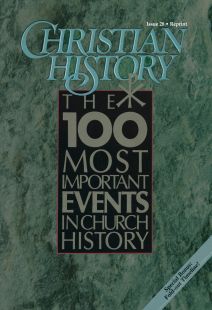1611 Publication of the King James Bible
“TO THE MOST HIGH AND MIGHTY PRINCE James by the Grace of God.” So begins the dedication in the most popular English Bible of all time, the Authorized Version, widely known as the King James Version. The much-loved KJV, as it is often abbreviated, may have fallen out of favor in recent years as more readable translations have been published for twentieth-century readers. But generation after generation of readers has absorbed its phrases. We can safely say that no other translation will ever have such an effect on the English language.
King James
Who was the “mighty Prince James” whose name has been stamped on millions of Bibles? He was the son of Mary Queen of Scots, executed by her half-sister, England’s Queen Elizabeth I. When the childless Elizabeth died, James, next male in the royal line, and already king in his native Scotland, marched south to London to be crowned king of England too. He is known to history as James I of England and James VI of Scotland.
Under Elizabeth, the Church of England had assumed an episcopal form of Protestantism. The growing number of Puritans felt Elizabeth had created a “compromise” church that wasn’t Protestant enough. They wanted to “purify” the church of anything that resembled Catholicism, including bishops, clerical garb, and high ritual. Before James had even reached London, the Puritans presented him with the Millenary Petition (so called because it had a thousand signatures), asking for moderate changes in the Church of England.
But James liked the Church of England’s episcopal structure and its title for the king, “Defender of the Faith.” James was, in fact, rather pretentious and committed to the idea that kings ruled by divine decree. (His contemporaries called him “the wisest fool in Christendom” and snickered that he was hardly the person to insist on kings’ divine rights.) James agreed to a conference, which met in January 1604 at Hampton Court. Here, however, James warned the Puritans that if they did not conform, he would “harry them out of the land.” The conference was a failure for the Puritans, except on one point: James gave his approval to the making of a new translation of the Bible.
Translation or Revision?
James wanted something to replace the popular Geneva Bible. This 1560 version was much loved by the people (and probably the version Shakespeare read), yet it had a perceived Calvinistic slant, something James didn’t like. The Puritans, meanwhile, disliked the Bishops’ Bible, an authorized 1568 version read in churches but not widely accepted by the common folk. England needed one version that both churches and individuals, and both the Church of England and the Puritans, could read with benefit.
In 1607, James appointed nearly fifty scholars and divided them into six companies. For two years and nine months they worked individually and in conference, and then the whole text was gone over by a committee of twelve. While the scholars used the original Hebrew and Greek, they closely followed previous translations. In fact, it may be inappropriate to call the King James Version a translation. As the “Preface of the Translators” explains, it is more accurately a revision of earlier versions. For example, the work of William Tyndale, the first major English translator, is evident in many passages.
The KJV has been called the “Authorized Version,” although, oddly, no proof has survived that James formally approved it. Officially, the new version was “appointed to be read in churches,” replacing the Bishops’ Bible. But it was a long time before it replaced the Geneva Bible as the Bible of the individual reader.
Bible English
Once established, however, the KJV was unshakable. Even though some critics said its language was archaic in the very year it appeared, later generations loved its “Bible English.” As the language evolved, becoming less and less like the language of James’s day, English-speaking Christians continued to express themselves in terms echoing the KJV. For example, many Christians still address God as “Thee” and “Thou.”
And how the language has been affected! Even if the KJV were to someday go out of print—which is unlikely—our language still bulges with such immortal expressions as “the skin of my teeth,” “Woe is me!” “a drop in the bucket,” “my brother’s keeper,” “holier than thou,” and many others.
But the effect goes beyond phrases. There is a cadence, a sentence rhythm, in the KJV that has never been matched in other English Bibles. If this beauty has detracted some readers from hearing the message, it has nevertheless been incredibly memorable and, therefore, memorizable. If learning Scripture is important, then committing it to memory is paramount, and we know that poetry—or poetic prose—is easier to memorize than flat prose. Today, almost four hundred years later, most people who can quote the Bible quote a version published in 1611.
Modern-day translators may rightly feel humble, knowing they can never produce a work that will so mold a language and shape an entire culture. CH
By
[Christian History originally published this article in Christian History Issue #28 in 1990]
Next articles
1738 John & Charles Wesley Experience Conversions
They were ordained ministers and missionaries. Then their hearts were “strangely warmed,” and their changed lives gave rise to a worldwide movement.
Roger J. Green1740 The Great Awakening Peaks
A mighty wave of revival washed across North America, forever altering the religious landscape.
Mark A. Noll1962 The Second Vatican Council
In an epochal council, the Catholic Church undertook its most searching self-examination ever and renewed itself for a modern world.
Joseph A. Komonchak1963 Martin Luther King, Jr. Leads the March on Washington
A Baptist preacher had a dream that guided one of the most profound social movements of our times.
Wesley A. RobertsSupport us
Christian History Institute (CHI) is a non-profit Pennsylvania corporation founded in 1982. Your donations support the continuation of this ministry
Donate



